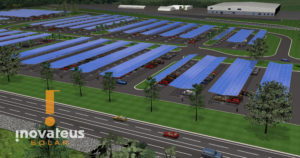Michigan State University’s Spartan Stadium seats 75,000 people – though we’re sure no one is sitting when the football team’s on the field. Like many institutions, faculty, staff, students and many other alumnae and fans come to campus to cheer on their team. Tailgating isn’t just getting ready for the game – it’s part of the experience. And part of that experience is taking up a substantial part of parking available on campus.
So MSU asked the question – can we make these parking lots more sustainable for our community?
Making Campuses More Sustainable
Michigan State University’s energy transition plan was adopted in 2012 with key goals to:
- Improve the physical environment
- Invest in sustainable energy research and development
- Become an educational leader in sustainable energy
These sustainability goals can be met in a number of ways, including energy efficiency improvements, replacing high carbon sources of energy and decreasing campus waste.
CustomerFirst Renewables (CFR) began working with MSU soon after the sustainability goals were adopted to pursue options that will help the institution reach its goals. After a thorough analysis of procurement options, together we decided an onsite renewable solution would be a substantial step in achieving MSU’s energy transition goals.
CFR helped MSU competitively source proposals for solar carports on five of the major asphalt surface parking lots on campus. MSU has now entered into a 25-year Power Purchase Agreement (PPA) with a developer who will build and own the carports.
Solar Panels in Parking Lots
 When the parking lots are not reserved for tailgating, students, faculty and staff drive and park in these lots every day. In meetings with MSU’s leadership team, concerns were raised that placing solar panels across five parking lots on campus could create conflicts with parking lot usage that users take for granted. CFR carefully considered a variety of factors to minimize any disruptions both during and after construction.
When the parking lots are not reserved for tailgating, students, faculty and staff drive and park in these lots every day. In meetings with MSU’s leadership team, concerns were raised that placing solar panels across five parking lots on campus could create conflicts with parking lot usage that users take for granted. CFR carefully considered a variety of factors to minimize any disruptions both during and after construction.
We dove into a fact-finding mission to determine:
- State height requirements for vehicle passage on state roads and bridges
- Standard RV and bus height most used for tailgating
- Structural requirements for increasing height of solar panels
- Safety considerations for panels that are taller
- Safety considerations for panels in high-traffic areas
- Impacts of the solar panels and superstructures on water control and erosion
- Impacts on ice and snow removal
- Safety and operational considerations around snow and ice shedding, ice melt and refreezing
- Safety issues around climbing of the structures by parking lot users, particularly during large events
- Structural design for wind load (if it’s too windy, will the panel functionality or safety be impacted)
- How to schedule construction so that there is a minimum of disruption to parking lot users
Making Changes
Through our work with MSU and the developer, we directed the design process to accommodate large vehicles. MSU’s solar carports will have a minimum clearance of 14 feet, 6 inches. Michigan standards for RVs are 13 feet, six inches, providing a foot of clearance for the largest of tailgating vehicles. The carport height will also accommodate MSU’s snow removal equipment.
As part of the design process, we also addressed the commercial arrangements and pricing to make sure MSU wouldn’t pay anything additional for raising the panels. This ensured MSU, a state university, would address its sustainability goals without passing extra costs onto students or state taxpayers. Based on projected electricity costs, this 25-year PPA will save money for the university, and therefore the state, over the course of the contract.
We ensured the space would continue to be functional – no parking spaces will be eliminated as a result of the solar installation. In fact, the panels will serve an additional function, protecting cars and pedestrians from sun and snow.
The Sun’s Impact on Spartan Life
The 39,960 solar panels will provide 5 percent of the university’s overall electricity use with an estimated annual production of about 15,000,000 kWh.
Construction at MSU has officially begun and is scheduled to minimize the impact on tailgating and everyday parking on campus. Estimated completion is November 2017.
Is your institution experiencing tailgating or energy procurement challenges? What solutions would you like to see implemented on your campus to make it more sustainable? Answer in the comments below!
Kevin Rackstraw is Vice President, Customer Solutions and leads CFR’s renewable supply activities. Kevin has over 25 years of renewable energy industry experience, including prospecting, site control, permitting, community relations, pre-construction design, power and asset sales, contracts and due diligence. Kevin has been leading CFR’s solution development activities since 2010.
The views, opinions and positions expressed by the authors and those providing comments on these blogs are theirs alone, and do not necessarily reflect the views, opinions or positions of the Association for the Advancement of Sustainability in Higher Education (“AASHE”).